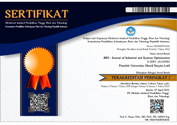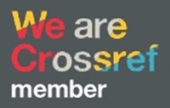IDENTIFIKASI BAHAYA TERHADAP AKTIVITAS FORKLIFT MENGGUNAKAN METODE HIRARC
DOI:
https://doi.org/10.51804/jiso.v4i1.38-42Keywords:
Hazard identification, work instruction, K3, Risk analysis, Risk ControlAbstract
ABSTRAK
Pada divisi CFS (Container freight Station) di PT. ABC, terdapat aktivitas forklift yang memiliki potensi tinggi untuk terjadinya kecelakaan yang dapat berakibat pada terhambatnya kegiatan dan dapat berimbas juga pada tingkat dwelling time. Oleh karena itu, perlu dilakukan identifikasi bahaya pada aktivitas forklift serta penilaian risiko dan pengendalian risiko sebagai rekomendasi perusahaan dalam mengurangi potensi kecelakaan. Penelitian ini adalah penelitian diskriptif kuantitatif dengan metode observasi pada aktivitas forklift berdasarkan intruksi kerja dan wawancara sebagai data penunjang. Hasil yang diperoleh dari identifikasi bahaya terdapat 9 aktivitas yang memiliki jenis bahaya dengan rincian 3 aktivitas memiliki level risiko High, 5 aktivitas memiliki level Medium, 1 aktivitas memiliki level low. Hasil pengendalian menunjukkan bahwa segi kontrol administrasi merupakan prioritas utama yang harus diperhatikan oleh perusahaan.
ABSTRACT
In the CFS (Container Freight Station) division at PT. ABC, there are forklift activities that have a high potential for accidents that can result in delays in activities and can also affect the dwelling time level. Therefore, it is necessary to identify hazards in forklift activities as well as risk assessment and risk control as company recommendations in reducing the potential for accidents. This research is a quantitative descriptive study with an observation method on forklift activities based on work instructions and interviews as supporting data. The results obtained from the identification of hazards are 9 activities that have the type of hazard with details of 3 activities having a high-risk level, 5 activities having a medium level, 1 activity having a low level. The results of the control show that the aspect of administrative control is a top priority that must be considered by the company.
References
Department of Occupational Safety and Health Ministry of Human Resources Malaysia 2008.
Elya Maula Imro’atul Khasanah, Erwin Dyah Nawawinetu | Journal of Vocational Health Studies 01 (2018): 20–27
Ramli, Soehatman. (2010). Pedoman Praktis Manajemen Risiko Dalam Prespektif K3 OHS Risk Manajemen. Jakarta: PT. Dian Rakyat.
Kurniawidjadja Meily,Teori dan Aplikasi Kesehatan Kerja (Universitas Indonesia:Jakarta,2010), h. 72.
Silalahi, B dan Silalahi, R. 1995. Manajemen Keselamatan dan Kesehatan Kerja. PT Pustaka Binaman Pressindo : Jakarta.
Suma’mur. 1998. Higiene “Perusahaan & Kesehatan Kerja”. CV Haji Masagung : Jakarta.
Sumarsono, Sonny. 2004. Metode Riset Sumber Daya Manusia. Graha Ilmu : Yogyakarta.
Nasution , M. 1994. Manajemen Personalia. Djambatan : Jakarta.
Moekijat. 1999. Manajemen Sumber Daya Manusia (Manajemen Kepegawaian). CV. Mandar Maju : Bandung.
Lidya, B dan Martono, A. M. 1996. Kesempatan Kerja. Pusat Pengemb angan Pendidikan Direktorat Jendral Pendidikan Tinggi Depdikbud : Bandung.
Handayani, D., & Purwanto, A. (2014). Penilaian Risiko Keselamatan Dan Kesehatan Kerja. Dinamika Rekayasa, 10(2), 68–75. https://doi.org/10.20884/1.dr.2014.10.2.8
Downloads
Published
Issue
Section
License
With the receipt of the article by JISO Editorial Board and the decision to be published, the copyright regarding the article will be transferred to JISO. The copyright transfer form can be downloaded here.
JISO has the right to multiply and distribute the article and every author is not allowed to publish the same article that was published in this journal.
JISO is licensed under a Creative Commons Attribution-ShareAlike 4.0 International License.
Under the following terms:
Attribution — You must give appropriate credit, provide a link to the license, and indicate if changes were made. You may do so in any reasonable manner, but not in any way that suggests the licensor endorses you or your use.
ShareAlike — If you remix, transform, or build upon the material, you must distribute your contributions under the same license as the original.














